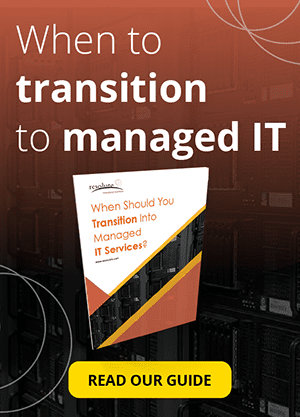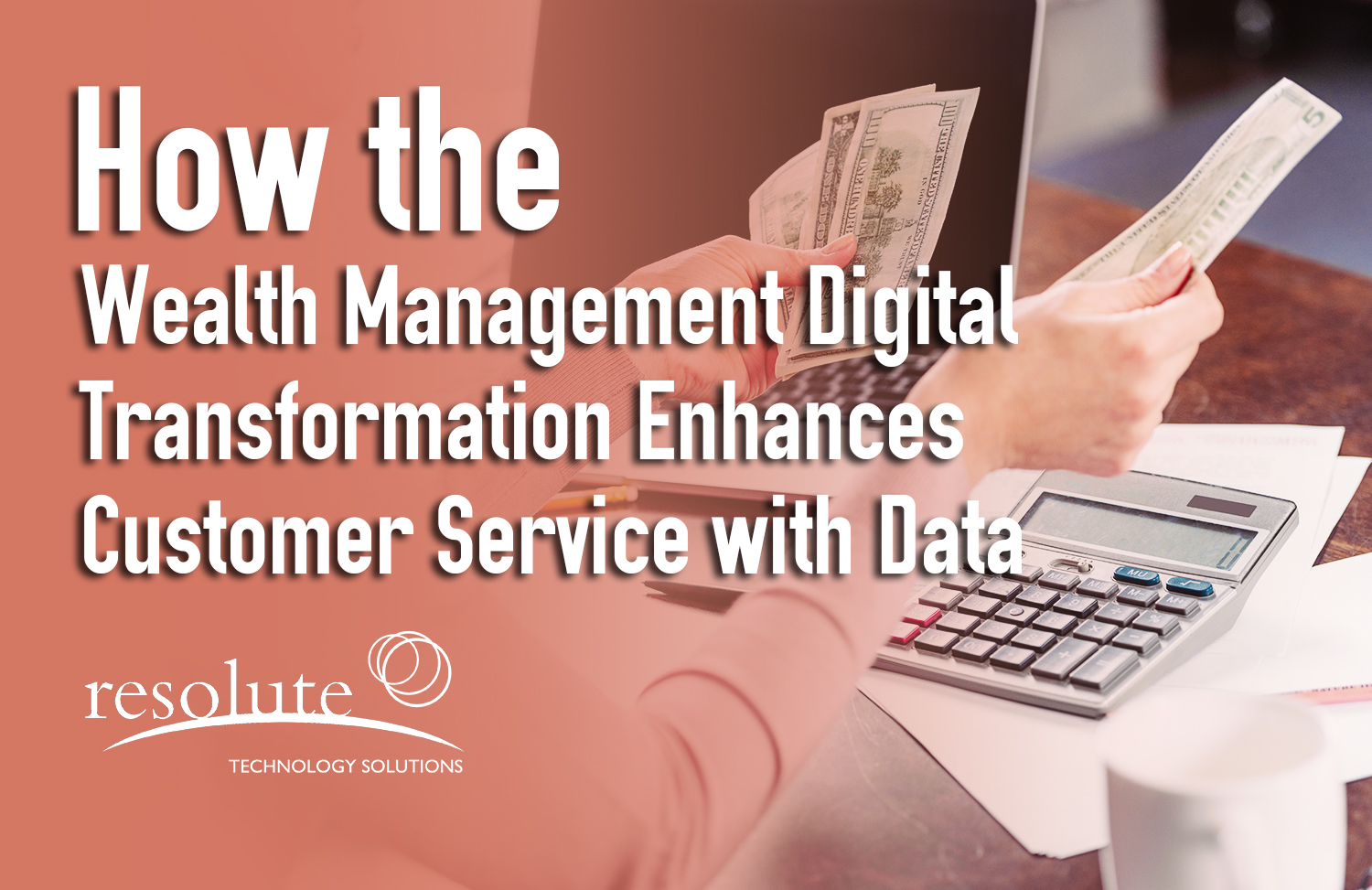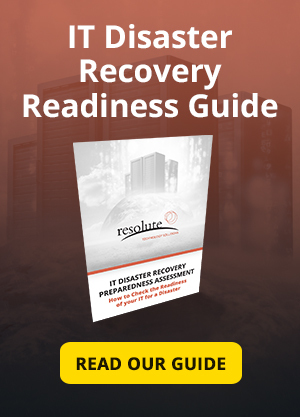Wealth Management Digital Transformation
In part one of this series, Resolute Technology Solutions’ President Rod De Vos provided an overview of how the financial industry is leveraging process automation and artificial intelligence to become more competitive.
In part-two, Rod outlines how the utilization of data and enhanced customer experience are essential to successful digital transformation in wealth management.
How Data helps Wealth Management Firms Understand their Clients’ Interests
Interviewer: Leveraging process automation is certainly a process that involves integrating multiple systems and having expertise on-hand to be able to integrate platforms and potentially code new ways of doing things, both at a technology and process level.
But we also know that there’s a lot of data just existing on hand at many wealth management companies. Could you speak to some trends relating to the use of existing data? Financial institutions have been collecting data, what experience have you had with that as it relates to some of the new trends in the market?
Using Data to Balance Portfolios and Automate Trades
Rod De Vos: So there’s more data being collected all the time by wealth management firms or financial services and institutions. Whether it’s credit card data, whether it’s mortgage data, whether it’s loan data, whether it’s your banking data or whether it’s your investment data through your wealth management accounts.
Sometimes, that’s brought together with data aggregators using third parties and you get a much broader view of the client’s wallet, like a balance sheet for the customer. Data in wealth management firms is being used for deeper automation and different purposes.
Let’s say a use case would be taking the data that’s in your original profile for your investment objectives and comparing the portfolio that we’ve created for you and then matching that to where the market’s at today in term of calculating the net worth of your portfolio.
So we would use the data from the market and what we have in your wealth management accounts and through monitoring and assessing how the portfolio drifted based on market pricing.
You use the drift in order to rebalance your portfolio to get that back on track to line up with your goal.
So I might be selling some stocks in your portfolio in order to reduce the risk in your portfolio to constantly keep alignment with your risk profile. In which case, again through automation, like a rebalance in your team I use logic in order to rebalance your portfolio to sell those shares and buy shares in a lower risk investment fund.
You Might Also Like:
- What to Consider When Upgrading or Replacing Your Financial Services IT System: Part 1
- What to Consider When Upgrading or Replacing Your Financial Services IT System: Part 2
- The Problems with Legacy Platforms in Financial Services IT
All of that with technology can actually generate a trade, so you can have automated asset trading and at the same time real-time compliance against those trades.
Many institutions basically have some or all of their systems integrated and automated in order to do so. In some hybrid models, it’s to offset the recommendations for the trades, and it goes back to the advisors who meet with the customers about approvals.
If the client has given full delegation in order for the advisory firm or the wealth management firm in order to just execute those trades on behalf of the customer, then full automation can happen and trades can be executed all the way through.
Colton De Vos: All this is possible because of the greater use of data. Being able to leverage that data and then make all these insights based on it.
Rod De Vos: So in that case we’re managing your risk profile information, your current situation in how many shares you own across your portfolio and an external piece of data, which is what’s happening in the market today.
Interviewer: One thing that caught my attention was that you said many if not all, institutions have their data integrated in such a way that it allows to have a backwards-looking reflection and could make decisions off previous data for future decision making.
Are there any blind spots or gaps in the use of data across financial institutions, whether it’s wealth management or otherwise?
Rod De Vos: I guess the blind spot is predictive because you can’t always predict what will happen in the markets. So you always work within a variance of tolerance. We don’t generate trades for every percentage of being out a balance from a risk profile perspective. You have to have tolerances.
Colton De Vos: Or a company that is so stuck with legacy systems that aren’t able to take advantage of some of the data that’s out there, be able to use it.
Need to Understand How to Fully Leverage Your Data?
Contact Resolute Today for a Free Consultation!
How Integrating Data Supports Complex Portfolio Management
 Interviewer: I think that’s where I’m trying to go in terms of the direction of this conversation.
Interviewer: I think that’s where I’m trying to go in terms of the direction of this conversation.
As you said, all financial institutions have been stockpiling every data point that they can. You had mentioned that all of the institutions have their data integrated in such a way that at least everything can be combed through if needed.
But how effective, if they do all have their systems integrated, are they in being able to actually utilize all of this data for various kinds of decision making, especially if there are legacy systems involved?
Rod De Vos: Sometimes it’s as if I had a simple portfolio and I basically have saved-up enough money to buy one mutual fund, there isn’t a lot to rebalance. It’s mostly for a whole portfolio worth of investments spread across multiple different asset classes. In which case, it’s more complex.
In today’s world, trying to balance world markets and some level of low-risk and high-risk in the same portfolio results in multiple asset classes, thus being a complex portfolio.
It doesn’t mean it has to be worth millions of dollars in order to achieve that, it’s just more that I’m balancing my portfolio and the risk within my portfolio by having more than one asset class in it.
In which case, traditional legacy systems – such as mutual fund system versus brokerage system versus a bond or a guaranteed investment certificate type system – they may be in very different systems. In which case, the portfolio comes together either through integration or another layer of software creating that.
The rebalance is a third or fourth piece of software that actually allows that business function to span across all those different asset classes.
Interviewer: As it relates to technology investments in financial services and the utilization of data, it’s really moving towards greater use of integrations and algorithms that allow you to also manage some of these more complex portfolios.
Currently, I would assume that many banks or financial institutions don’t have the capacity of managing some of the more complex financial products and perhaps clients and their portfolios.
Rod De Vos: Through the use of data that’s the trigger for knowing that we should be doing something different with your portfolio. We use data to trigger that.
The triggers themselves are software in order to determine what to do with it. Human intervention, whether it’s advice or artificial intelligence (built into it), as well as process automation can make all of that happen.
Learn More About Dealing With Legacy Applications:
- Maintaining vs. Replacing Legacy Systems
- How to Manage the Costs of Your Outdated Legacy Applications
Leveraging Data to Enhance the Customer Service Experience
Shift to a Client-Centric User Experience
Interviewer: We’re talking about the functional rebalancing and the mechanical trades that would happen to an investment that already exists or an asset class that already exists.
But how are banks or financial institutions using some of that data in a more client-facing engagement? Or is there any relation to the use of data for enhanced user experience and what trends are you seeing around overall user experience with financial services companies?
Rod De Vos: They’re moving much more towards it. Before, when you had an investment account, it would be an account-based type system, and that would be the user experience. Enter your account number and you would see your portfolio show up.
With all of that data coming from different areas and in the use of the data, the financial institutions are able to move to a client-centric – i.e. not-policy (in the insurance world) or account-based in the wealth management world. So they’re moving to a client-centric view where clients themselves can see essentially their entire portfolio spread-out.
The financial institutions are looking at data and everything a client has with the firm in order to determine how best they can service that customer.
They use the data to determine – and their own process, i.e. automation – to determine what the pain-points are in the customer’s journey and then determine how to enhance it by creating sort-of the ‘wow moments’ in a digital experience.
When to tie in the human advisor or when to promote that your portfolio has grown by X-percent instead of waiting for quarterly statements, you can get statements daily. You can see the growth of a dollar and other such ways that has really engaged the customer in a much different way.
Also, with the use of technology, they will support multiple channels. So it doesn’t really matter whether I’m on the web, looking it up or whether I’m using my phone or tying into different user groups in terms of use of social or bots and getting advice from a robo-advisor online.
Colton De Vos: Yes so the service and the support that you get back is basically the same regardless of what channel you access to get through.
Rod De Vos: And the smarter the investor they want the ability to manage essentially their wealth management relationship. No longer at the kitchen table and not necessarily at the branch, they want to be able to manage that relationship digitally.
Whether it’s through chat or email, with a robo-advisor or a real advisor.
Need Custom Web and Mobile Apps?
Contact Resolute Today!
Integrating Multiple Customer Service Channels to Improve User Experience
Interviewer: So, to summarize what you’re talking about, we have massive databases of client information and wealth management, past trades, and market information.
We’re merging that together with some of the client data itself to be able to, of course, make automated trades and automated decisions about their financial asset balancing and their asset classes.
But we’re also integrating that with various channel capabilities so that we’re not only making the best decisions for them about their existing investments.
But we’re also able to have a pretty consistent conversation well into the future so that if the client had called in over the phone and had made small requests or recommendations for their account.
That engagement is logged such that a robo-advisor might send an email or an automated request through the app that’s in line with their most recent phone call.
The client’s experience on the web application when they log-in reflects their most recent engagements. If a real advisor reaches out and starts a conversation a month-or-two later they’re not repeating a conversation that had already occurred.
There’s this feeling that working with the financial institution is like working with simply one person rather than working with many disconnected people.
Rod De Vos: Yes. It’s trying to control the customer service across omnichannel(multiple service channels i.e. in person, phone, website, branch, paper statement).
Interviewer: The omnichannel is incredibly important as part of the overall digital transformation in wealth management. How far along would you say are the various wealth management firms along in terms of omnichannel deployment?
Of course, you stated that many of the databases have been integrated and the data’s being used very deeply for some of those current investments and current decisions, but how well are financial services firms forward-integrated across this omnichannel with that data?
Rod De Vos: As you know, with mobile apps you can do a fair bit, much more than punching in all these codes over essentially an interactive voice response system over the phone.
In other words, the technology itself will sometimes go farther in one channel than the other simply because of the limitations of one of the technologies on the channel.
However, the back-end piece of the data is the same. So, you can get the same answer from multiple channels.
Colton De Vos: Yes, it’s a people and a process thing as well as the technology whereas you could have a real well-polished app that could respond to whatever your query is. People are still trying to figure out how to use social to interact, depending on the case.
Rod De Vos: Yes, in a secure way.
Interviewer: What would you say is involved in the process if a wealth management firm was looking to achieve this level of enhanced customer experience for any financial services in terms of technology?
What would you recommend as the steps involved in being able to have this degree of integration, if their databases are already at this stage of being connected together?
Rod De Vos: What’s involved is you have to separate yourself like the technology of the channel from the back-end systems where the data exists. So you’re basically creating an integration layer for servicing your customers on an omnichannel basis.
That essentially goes on its own and talks to the back end and produces the same answer regardless of what channel asset. It’s another layer of essential technology, entirely.
Interviewer: As you said, many of the technologies exist across the different channels. Social media platforms exist, websites exist, the data exist, etc. But being able to make all of that work in unison is a whole comprehensive layer of technology integration.
Rod De Vos: Yes. Correct.
In part three of the IT Trends in Finance series, Rod De Vos discusses how cyber-security and the cost of operating under emerging regulatory changes increasing the cost of providing financial services.
Enhancing security and placing new frameworks for adhering to regulatory requirements are essential technology investments in wealth management.
Resolute Technology Solutions’ Managed IT Services can help relieve you of taxing back-end IT support tasks, freeing you to perfect your front-end engagement with customers. Contact us to see how we can flexibly meet your technology needs.
[]










